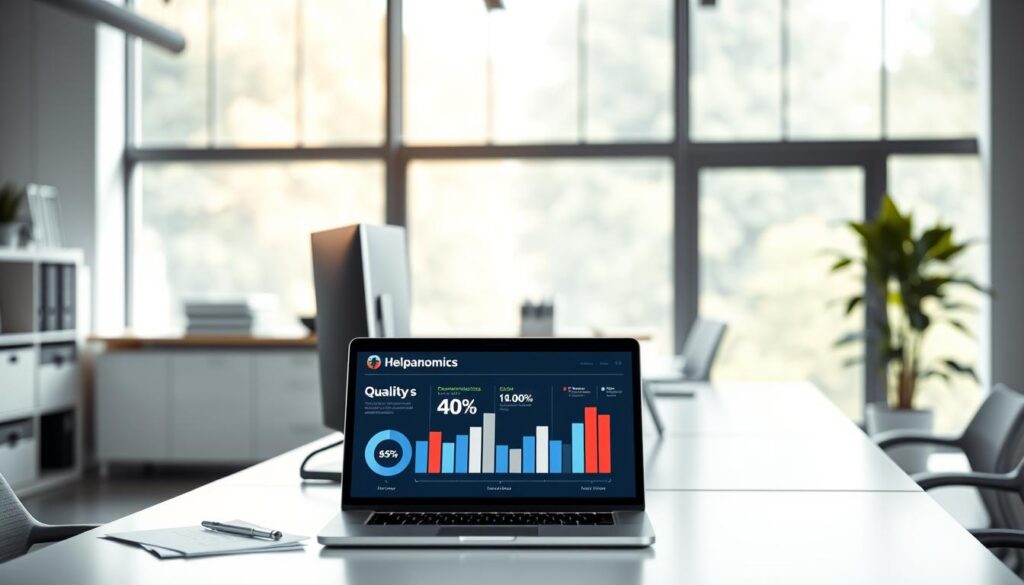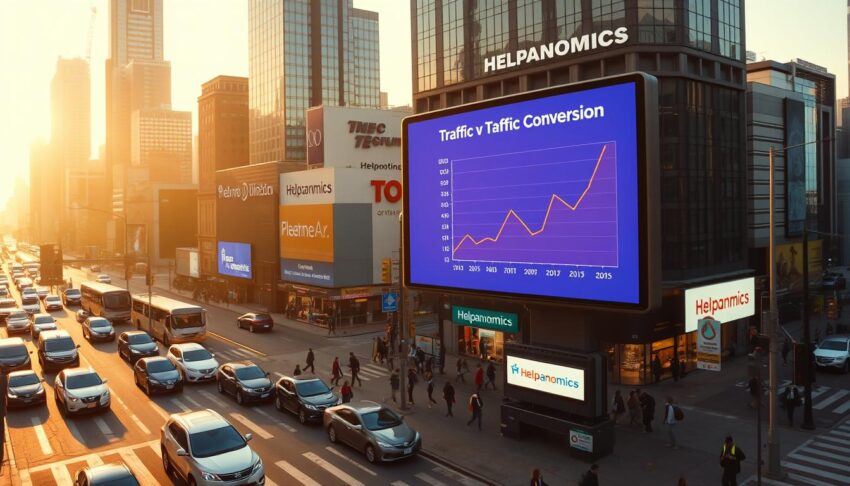In the world of online marketing, knowing the difference between website traffic and conversions is key. Many marketers aim to get more people to their site. But, it’s just as important to turn those visitors into customers.
When I started, I was excited to see more visitors. But, I soon found out that the real challenge was making those visitors pay customers. This is why knowing the difference between traffic and conversions is so important.
Key Takeaways
- Understanding the difference between traffic and conversions is crucial for online marketing success.
- Focusing solely on driving traffic is not enough; converting visitors into customers is equally important.
- A clear understanding of traffic and conversions can help you optimize your marketing strategy.
- Converting visitors into customers requires a well-planned approach.
- Analyzing traffic and conversions can help you identify areas for improvement.
Understanding the Digital Marketing Landscape
As I explore the digital marketing world, it’s key to know what drives success. The digital marketing scene is always changing, with new tech and platforms popping up all the time.
This change affects how we measure online success. To keep up, understanding online marketing metrics is crucial. They help us see how well our efforts are doing.
The Evolution of Online Marketing Metrics
Online marketing metrics have changed a lot over the years. At first, we focused on page views and click-through rates. But as digital marketing grew, we started looking at things like conversion rates and customer lifetime value.
Now, businesses have a lot of data to work with. This lets them make smart choices about their marketing plans. The shift in online marketing metrics has changed how businesses approach digital marketing.
Why Measuring Success Matters for Your Business
Measuring success is vital for any business. It lets us check how our marketing plans are working and find ways to get better. By watching key performance indicators (KPIs), we can make our marketing better and use our resources wisely.
Also, measuring success helps us see how much we’re getting back from our investments (ROI). In today’s digital world, knowing your success is not just helpful—it’s necessary to stay ahead.
What is Website Traffic?
As a digital marketer, knowing about website traffic is key. It’s the number of people visiting your site in a set time. It shows how well your online presence is doing.
Website traffic includes many types of visitors. Knowing these types is important for a good digital marketing plan.
Types of Traffic Sources
Traffic sources can be broken down into several types. These include organic, paid, direct, referral, and social traffic.
Organic vs Paid Traffic
Organic traffic comes from search engines. Paid traffic comes from ads. Organic traffic is often seen as more valuable because it’s targeted and saves money.
Direct, Referral, and Social Traffic
Direct traffic is when people type your site’s URL directly. Referral traffic comes from other sites linking to yours. Social traffic comes from social media. Knowing these helps you find the best channels for your business.
Key Traffic Metrics You Should Track
To really understand your website traffic, track important metrics. These are:
- Page views
- Unique visitors
- Bounce rate
- Average session duration
| Metric | Description | Importance |
|---|---|---|
| Page Views | Total number of pages viewed | High |
| Unique Visitors | Number of new visitors | High |
| Bounce Rate | Percentage of visitors who leave immediately | Medium |
| Average Session Duration | Time spent on the website | Medium |
What are Conversions?
Understanding conversions is key for any business online. Conversions are the actions visitors take, like buying something or signing up for a newsletter. They are the main goal of digital marketing.
Defining Conversion Goals
Setting conversion goals is vital for conversion rate optimization. It means figuring out what actions are most important for your business. By doing this, you can make your website more appealing to your audience.
Different Types of Conversions
Conversions can vary based on your business and goals. Knowing the different types is crucial for a good conversion rate optimization plan.
Micro-Conversions
Micro-conversions are smaller steps toward a bigger goal. They include things like downloading a whitepaper or adding a product to your cart. These actions show progress in the customer journey.
Macro-Conversions
Macro-conversions are your main business goals, like making a purchase or filling out a form. These actions are key to your success and impact your profits.
Traffic vs Conversions – What’s the Difference?
As a marketer, knowing the difference between traffic and conversions is crucial. Both are important in digital marketing but show different things about your online presence. Getting this right can make your marketing better.
Quantity vs Quality Perspective
The debate between quantity and quality is key when talking about traffic and conversions. Having lots of visitors might seem good, but if they don’t buy or sign up, it’s not quality traffic. On the other hand, fewer visitors who are more likely to buy can lead to more sales. It’s not just about getting any visitors; it’s about getting the right ones.
For example, a site with 10,000 visitors a month and a 1% conversion rate is the same as a site with 1,000 visitors and a 10% conversion rate in terms of sales.
| Metric | Traffic Focus | Conversion Focus |
|---|---|---|
| Primary Goal | Increase visitor count | Achieve specific actions |
| Quality Indicator | Engagement metrics (time on site, bounce rate) | Conversion rate, revenue per visitor |
| Marketing Strategy | SEO, content marketing, paid advertising | Landing page optimization, CTAs, A/B testing |
The Relationship Between Traffic and Conversions
Traffic and conversions are connected but different. You need visitors to have conversions, but more visitors don’t always mean more sales. The rate at which visitors buy or sign up depends on your content, how easy it is to use, and your calls to action. To get more sales, you need to work on getting more visitors and making them more likely to buy.
By understanding the difference between traffic and conversions, you can make a better digital marketing plan. This plan will not only bring in visitors but also turn them into customers.
Why High Traffic Doesn’t Always Equal Success
Having lots of website visitors might look good, but it doesn’t always mean you’re reaching your goals. The real secret is knowing the difference between just traffic and lead generation.
High traffic can be misleading. It might include people who aren’t really interested in what you offer. This can make you think your site is doing better than it really is.
The Vanity Metrics Trap
Getting too caught up in traffic numbers can trap you in the vanity metrics trap. You might focus on numbers that look good but don’t really help your business. For example, a high bounce rate or low engagement could mean your content isn’t connecting with your audience.
When Traffic Fails to Convert: Real-World Examples
Imagine a site gets a lot of visitors because of a viral post. The numbers might look great, but if those visitors don’t turn into leads or sales, it’s not worth it. A company once saw a big increase in traffic during a campaign but their conversion rate stayed the same.
To avoid this, focus on lead generation and conversion rates, not just visitor numbers. This way, you make sure your online marketing is actually helping your business succeed.
The Value of Quality Conversions
For businesses aiming to succeed in the digital world, focusing on quality conversions is key. As a beginner, it’s crucial to know that not all conversions are the same.
Quality conversions lead to meaningful outcomes like sales or sign-ups. They come from targeted efforts to attract the right audience. These efforts guide them through a well-designed conversion funnel.
Impact on Revenue and Business Growth
Quality conversions directly impact revenue and business growth. Focusing on converting high-quality leads can lead to a significant return on investment (ROI). These leads are more likely to become paying customers.
- Increased revenue through targeted conversions
- Improved ROI due to efficient use of resources
- Better customer acquisition costs
Building Customer Loyalty Through Conversions
Conversions are not just about one-time deals; they help build a loyal customer base. A seamless conversion experience fosters loyalty and encourages repeat business.
To achieve this, consider these strategies:
- Personalize the user experience to resonate with your target audience
- Ensure a smooth and intuitive conversion process
- Follow up with customers to build a relationship and encourage repeat business

By focusing on quality conversions and using these strategies, beginners can set their businesses up for success. They can create a loyal customer base that drives long-term growth.
How to Analyze Your Website Traffic
Understanding your website traffic is crucial for making smart digital marketing choices. By looking at your website traffic, you learn about your audience’s likes, dislikes, and who they are. This helps you fine-tune your seo strategy to reach your audience better.
Essential Analytics Tools for Beginners
For beginners, tools like Google Analytics are great for tracking your website’s performance. They give you insights into where your traffic comes from, how users behave, and how well you convert visitors. This helps you improve your online marketing plans.
Step-by-Step Guide to Interpreting Traffic Data
Here’s how to understand your traffic data:
- Find out where your visitors come from to see your audience’s origins.
- Look at how users behave, like bounce rates and how long they stay, to see if they’re engaged.
- Watch your conversion rates to see how well your seo strategy works.
How to Identify Valuable Traffic Sources
Not all visitors are the same. To find the best ones, look at metrics like conversion rates, average order value, and customer lifetime value. This way, you can focus your online marketing on attracting the right kind of traffic that helps your business grow.
As Avinash Kaushik, a top digital marketing expert, once said,
“The best marketers are not those who are the most creative, but those who understand their customers the best.”
By studying your website traffic and knowing your audience, you can make marketing campaigns that really work.
Measuring and Tracking Both Metrics Together
Understanding how traffic and conversions work together is crucial for your digital marketing. By tracking both, you get a full picture of your website’s performance. This helps you find ways to get better.
To track both well, start with conversion tracking. Decide what counts as a conversion, like a form fill or a purchase. Conversion rate optimization is key here. It shows how well your site turns visitors into customers.
Setting Up Conversion Tracking
To track conversions, use Google Analytics. Add a tracking code to your site and set up goals that match your conversion types. This way, you can see how different sources help your conversions.
Creating Meaningful Reports and Dashboards
With tracking set up, make reports and dashboards that show your site’s performance. Choose metrics like conversion rate, traffic, and revenue. Analyzing these together helps spot trends and patterns for your marketing strategy.
Tracking both traffic and conversions helps you make smart decisions. These decisions can grow your business and boost your online presence.
Strategies to Increase Quality Website Traffic
To succeed online, focusing on quality traffic is key. We’ll look at the best ways to boost your website’s visibility. These methods will help attract the right people to your site.

SEO Fundamentals for Better Visibility
Search Engine Optimization (SEO) is vital for more organic traffic. Improve your site’s structure, content, and meta tags to rank higher. Use long-tail keywords like “digital income guide for 50+” to attract the right audience.
Content Marketing Approaches for Your Target Audience
Content marketing draws in and keeps your audience. Create high-quality, informative, and entertaining content. Use blog posts, videos, and social media to share it widely. This way, you offer value and encourage sharing and return visits.
Smart Paid Traffic Acquisition Methods
Paid traffic can also boost your site’s visibility. Google Ads and Facebook Ads target specific groups. This ensures your ads reach the right people. Paid ads can drive traffic fast and support your SEO efforts.
A study shows combining SEO and paid ads can increase traffic by up to 25%. This highlights the need for a mix of strategies to boost your website’s traffic.
Conversion Rate Optimization Techniques
Conversion rate optimization is key to turning website visitors into loyal customers. By using effective CRO techniques, you can boost your website’s performance and increase sales.
Improving User Experience for Higher Conversions
User experience greatly affects conversion rates. A smooth, easy-to-use website can significantly boost conversions. Focus on making navigation simple, page loads fast, and ensure it works well on mobile.
A well-designed website should be easy to navigate. A fast and secure website is also essential. Slow loading times can cause visitors to leave quickly.
Creating Effective Call-to-Actions That Convert
Call-to-actions (CTAs) are crucial for guiding visitors. Use action-oriented language and make them stand out. Ensure they match the content.
For example, using action verbs like “Sign Up” or “Get Started” can motivate visitors. CTAs should be easy to see and placed well on the website.
A/B Testing: A Beginner’s Guide
A/B testing compares two webpage versions to see which one works better. It helps you find areas to improve and make informed decisions.
To start A/B testing, know your goals, create different webpage versions, and use tools to analyze results. Start with small changes to avoid overwhelming visitors.
| CRO Technique | Description | Benefits |
|---|---|---|
| User Experience Optimization | Simplifying navigation, optimizing page load times, and ensuring mobile responsiveness | Improved conversion rates, reduced bounce rates |
| Effective Call-to-Actions | Using action-oriented language, making CTAs prominent, and ensuring relevance | Increased conversions, enhanced user engagement |
| A/B Testing | Comparing two versions of a webpage to determine which one performs better | Data-driven decision making, improved conversion rates |
Balancing Traffic and Conversion Efforts for Digital Income
Making money online needs a fine balance. You must draw in visitors and turn them into buyers. It’s key to understand how traffic and conversions work together in the digital world.
Creating a Holistic Digital Marketing Strategy
A good digital marketing plan combines many online metrics. It uses SEO, content marketing, and ads to bring in the right visitors.
It’s better to focus on quality over quantity. Know your audience well and make your marketing fit their needs.
Resource Allocation for Maximum ROI
Spending resources wisely is vital for digital marketing success. You should spread your efforts across social media, email, and content.
| Channel | Traffic Potential | Conversion Potential |
|---|---|---|
| Social Media | High | Medium |
| Email Marketing | Medium | High |
| Content Creation | Medium | High |
By checking how each channel does, you can decide where to put your resources. This way, you get the best return on investment.
Conclusion
Knowing the difference between traffic and conversions is key for a good digital marketing plan. Traffic is the number of people visiting your site. Conversions are the actions those visitors take that help your business.
To do well online, you need to balance getting more visitors and making those visits count. By looking at your website’s traffic and conversion rates, you learn a lot about your audience. This helps you understand what they like and want.
When you focus on the difference between traffic and conversions, you can make better plans. For example, you can use SEO to get more quality visitors. And you can use conversion rate optimization to get more people to take the actions you want.
By using these tips, you can make your digital marketing better. This will help your business grow. Remember, knowing the difference between traffic and conversions is important for success online.
